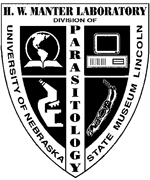Parasitology, Harold W. Manter Laboratory of
Document Type
Article
Date of this Version
3-7-2024
Citation
Parasitology International 101 (2024) 102885. https://doi.org/10.1016/j.parint.2024.102885
Abstract
Host phylogeny and ecological convergence are two factors thought to influence the structure of parasite communities. The aims of this study were to determine the diversity of metazoan parasites of 10 sympatric fish species of the family Carangidae from the southeastern Gulf of California, and to analyze their similarity at infracommunity and component community levels, in order to determine if the host species, particularly those congeneric with similar ecological characteristics, exhibit similar assemblages of parasites. In total, 874 fish specimens were examined and 40 parasite species were identified. The component community was composed by 21 parasite species in Caranx caninus, 20 in C. caballus, 11 in C. vinctus, five in Chloroscombrus orqueta, four in Carangoides otrynter, seven in Hemicaranx leucurus, eight in Selene brevoortii, 14 in S. peruviana, and 11 in Trachinotus rhodopus. The metazoan parasite communities of C. vinctus, Ch. orqueta, H. leucurus, and S. brevoortii are reported here for the first time. The parasite communities of the remaining six carangid species have been reported from regions other than the Gulf of California. All fish species differed significantly regarding the diversity of their parasite infracommunities. This possibly is due to different patterns of habitat use among fish species, and because of the differential host specificity among parasite taxa. Nonetheless, when the analysis was restricted to common parasite species, some fish showed similar parasite infracommunities, particularly congeners of the genus Selene as well as C. caballus and C. vinctus. The component communities of species of Selene were highly similar (>65%), but the three species of Caranx were not. This result supports the hypothesis that congeneric fish species with similar ecological filters harbor similar parasite communities. However, the difference observed between C. caninus and C. caballus suggests that these species, despite being evolutionary and ecologically related, have different physiological or immunological characteristics (compatibility filters) that may result in different parasite communities.


Comments
Open access.